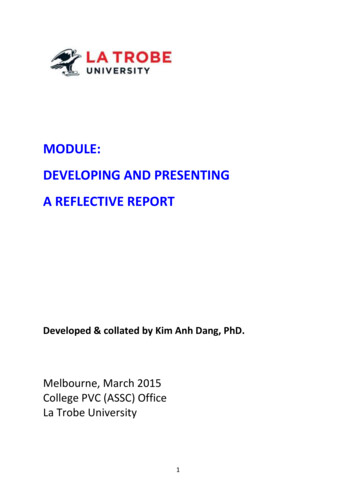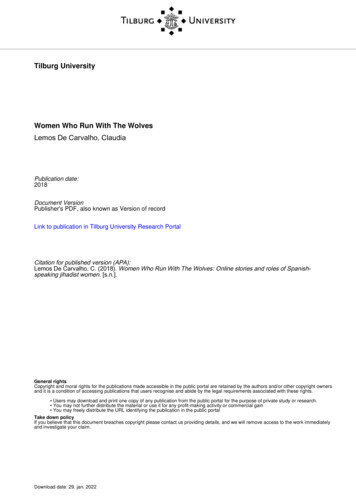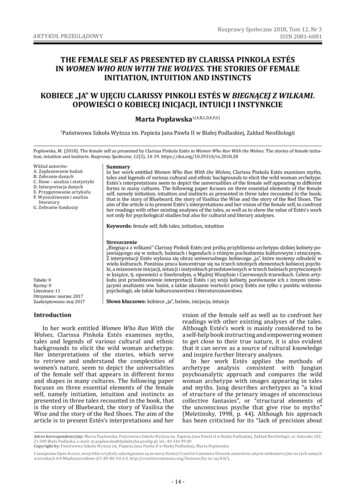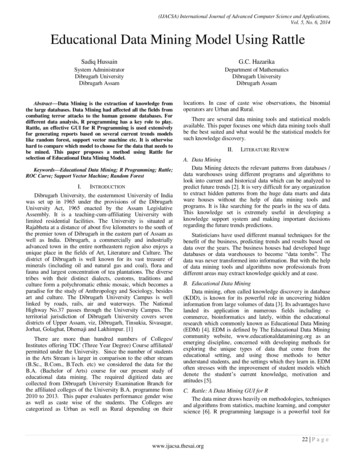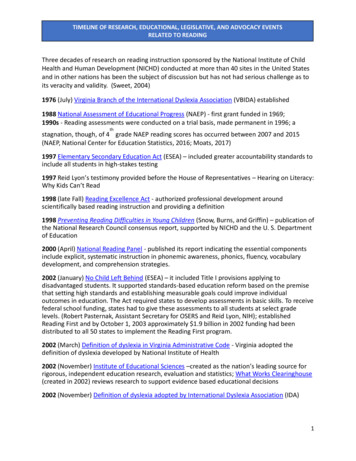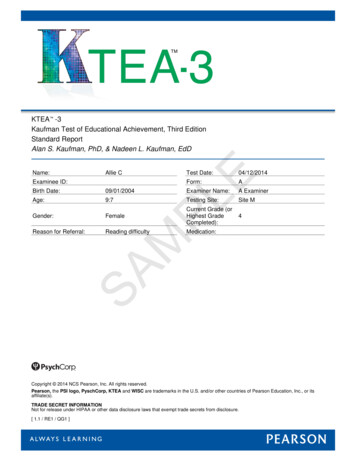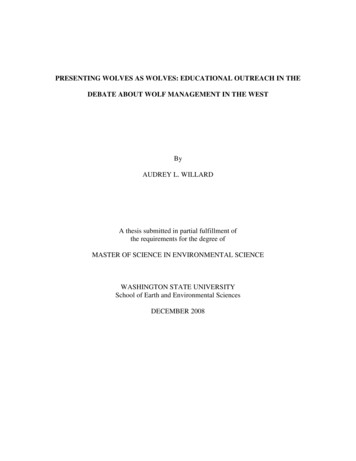
Transcription
PRESENTING WOLVES AS WOLVES: EDUCATIONAL OUTREACH IN THEDEBATE ABOUT WOLF MANAGEMENT IN THE WESTByAUDREY L. WILLARDA thesis submitted in partial fulfillment ofthe requirements for the degree ofMASTER OF SCIENCE IN ENVIRONMENTAL SCIENCEWASHINGTON STATE UNIVERSITYSchool of Earth and Environmental SciencesDECEMBER 2008
To the Faculty of Washington State University:The members of the Committee appointed to examine the thesis ofAUDREY L. WILLARD find it satisfactory and recommend that it be accepted.Chairii
ACKNOWLEDGEMENTSSeeking knowledge, inspiration, and new opportunities, I embarked on a questthrough Washington State University two years ago. My passage through graduateschool was both rewarding and challenging, and I could not have completed my journeyalone. The support of my family, friends, and professors has given me the strength toachieve and surpass my highest expectations.Many professors have shared their knowledge and wisdom with me throughoutthe completion of my thesis. Rick Gill took me under his wing when I first arrived atWSU and encouraged me to carve my own path in my coursework and research. MattCarroll’s support and knowledgeable insights into the sociological aspects ofenvironmental conflict provided additional direction for my research goals. EmmettFiske’s words of encouragement inspired me to pursue my passion and study the wolfmanagement conflict. Emmett’s enthusiasm and motivation have taught me theimportance of following my heart and making a difference in the world, for which I willbe eternally grateful. Other faculty and staff who have contributed their knowledge andinsights along my journey include Allyson Beall, David Greenwood, Troy Hall (UI), LisaMcIntyre, George Mount, Elaine O’Fallon, and Eugene Rosa.My colleagues, classmates, and friends have helped me endure the challenges ofgraduate school. I am especially thankful for the many words of wisdom and supportfrom Courtney Bennett, Asmeret Bier, Marla Chassels, Dan Crowther, RebeccaGreenwood, Kim Hamblin-Hart, Hayley Palmer Andrus, Chris Pell, Laura Robison,Heidi Sowell, Allison Wesockes, and Kara Whitman.iii
This great journey would not have been possible, or even imaginable, without theenduring support of my amazing family. My parents, Rick and Connie Otto, instilled inme the curiosity, compassion, and confidence to pursue my dreams and never settle forless. I am incredibly grateful for their constant love and encouragement. My motherand father-in-law, Roger and Sherri Willard, have demonstrated their unendinggenerosity and support, standing by me every step of the way. My appreciation for theirlove and patience throughout the past two years is indescribable. In spite of the greatdistance between us, my grandparents (Ervin and Lydia Otto and Barbara Hughes), mybrother and sister-in-law (Ryan and Louisa Otto), and my sister-in-law’s family (Jeff,Kim, Abby, Jaycee, and Bryce Snell) have also given me their continuous support.Above all, I am especially thankful for my extraordinary husband’s unwaveringlove and support throughout this grand adventure. Kory’s willingness to move our livesacross the country was the ultimate act of generosity and faith. I have been able toachieve my goal of completing a master’s degree because he believes in me and is myconstant support system. Although we faced many challenges along the way, my successwould not have been possible without him by my side.iv
PRESENTING WOLVES AS WOLVES: EDUCATIONAL OUTREACH IN THEDEBATE ABOUT WOLF MANAGEMENT IN THE WESTAbstractby Audrey L. Willard, M.S.Washington State UniversityDecember 2008Chair: Emmett FiskeThroughout history the fate of wolves has been a reflection of shifting beliefsabout the environment. As United States citizens adopt values and laws to protect theenvironment and wildlife, the new ideas are often at odds with more traditional utilitarianvalues. Decades after their extirpation from the west, the reintroduction of gray wolvessparked controversy about wolf management. Like most environmental conflicts, thedebate about wolf management in the west is riddled with scientific, social, and politicalcomplexities. Many groups have responded to the debate in an attempt to promoteunderstanding and reduce conflict.In light of the underlying values and the issues that emerge from the value-drivennature of the wolf management debate, I sought to identify the role of education inreducing conflict. I interviewed twenty individuals representing wildlife managementagencies, organizations advocating wolf conservation, educational organizations,organizations advocating wolf delisting, and the media.My interview analysis revealed many valuable insights into the educationaloutreach developed in response to the debate about wolf management. In particular,v
environmental education serves as a means to present science alongside values, breakdown communication barriers, and create opportunities for unique learning experiences.By building upon the essential themes described in my interviews and the literature, Ideveloped a contemporary paradigm to guide educators working in the midst ofenvironmental controversy. Above all, educators must not only inform their audiencesbut also connect with them. As environmental controversies become more widespreadwith shifting value systems and limited resources, educators may use this new approachto foster understanding and reduce conflict.vi
TABLE OF CONTENTSPageACKNOWLEDGEMENTS. . . . . . . . . . . . . . . . . . . . . . . . . . . . . . . . . . . . . . . . . . . . . . . . iiiABSTRACT. . . . . . . . . . . . . . . . . . . . . . . . . . . . . . . . . . . . . . . . . . . . . . . . . . . . . . . . . . . . .vLIST OF TABLES. . . . . . . . . . . . . . . . . . . . . . . . . . . . . . . . . . . . . . . . . . . . . . . . . . . . . . . ixLIST OF FIGURES. . . . . . . . . . . . . . . . . . . . . . . . . . . . . . . . . . . . . . . . . . . . . . . . . . . . . . .xCHAPTER1. INTRODUCTION. . . . . . . . . . . . . . . . . . . . . . . . . . . . . . . . . . . . . . . . . . . . . . . .12. REVIEW OF THE LITERATURE. . . . . . . . . . . . . . . . . . . . . . . . . . . . . . . . . . .3The Eradication of Wolves from the West. . . . . . . . . . . . . . . . . . . . . . . . . 3The Emergence of Ecology. . . . . . . . . . . . . . . . . . . . . . . . . . . . . . . . . . . . . 5Gray Wolf Recovery in the Northern Rocky Mountains. . . . . . . . . . . . . . .7Values Driving the Conflict. . . . . . . . . . . . . . . . . . . . . . . . . . . . . . . . . . . .12Dynamics of Value-Driven Conflicts. . . . . . . . . . . . . . . . . . . . . . . . . . . . 15Value-Driven Conflict and Educational Outreach. . . . . . . . . . . . . . . . . . .16Multiple Ways of Knowing. . . . . . . . . . . . . . . . . . . . . . . . . . . . . . . . . . . .17Impacts of Literature and Media. . . . . . . . . . . . . . . . . . . . . . . . . . . . . . . . 18Suggested Methods for Environmental Education. . . . . . . . . . . . . . . . . . 19Dialogue to Foster Understanding. . . . . . . . . . . . . . . . . . . . . . . . . . . . . . .20Science in Multidisciplinary Environmental Education. . . . . . . . . . . . . . 22Research Question. . . . . . . . . . . . . . . . . . . . . . . . . . . . . . . . . . . . . . . . . . .233. RESEARCH METHODS. . . . . . . . . . . . . . . . . . . . . . . . . . . . . . . . . . . . . . . . . 24Building My Knowledge Base. . . . . . . . . . . . . . . . . . . . . . . . . . . . . . . . . .24vii
Methodology. . . . . . . . . . . . . . . . . . . . . . . . . . . . . . . . . . . . . . . . . . . . . . . 25Sampling Process. . . . . . . . . . . . . . . . . . . . . . . . . . . . . . . . . . . . . . . . . . . .25Interview Research Design. . . . . . . . . . . . . . . . . . . . . . . . . . . . . . . . . . . . 27Coding Interviewees into Analysis Groups. . . . . . . . . . . . . . . . . . . . . . . .28Analysis Process. . . . . . . . . . . . . . . . . . . . . . . . . . . . . . . . . . . . . . . . . . . . 304. INTERVIEW DISCOVERIES. . . . . . . . . . . . . . . . . . . . . . . . . . . . . . . . . . . . . 32Group Goals Within the Conflict . . . . . . . . . . . . . . . . . . . . . . . . . . . . . . . 33Issues Emerging from the Value-Driven Nature of the Debate. . . . . . . . .37The Role of Education in Reducing Conflict and BuildingUnderstanding. . . . . . . . . . . . . . . . . . . . . . . . . . . . . . . . . . . . . . . . . . . . . . 43The Presentation of Scientific Information Alongside SocialDefinitions. . . . . . . . . . . . . . . . . . . . . . . . . . . . . . . . . . . . . . . . . . . . . . . . . 43Creating the Opportunity for Unique Learning Experiences. . . . . . . . . . .47Breaking Through Communication Barriers. . . . . . . . . . . . . . . . . . . . . . .515. IMPLICATIONS FOR ENVIRONMENTAL EDUCATION ANDOUTREACH. . . . . . . . . . . . . . . . . . . . . . . . . . . . . . . . . . . . . . . . . . . . . . . . . . . 56REFERENCES. . . . . . . . . . . . . . . . . . . . . . . . . . . . . . . . . . . . . . . . . . . . . . . . . . . . . . . . . 60APPENDIXA. CERTIFICATE OF EXEMPTION . . . . . . . . . . . . . . . . . . . . . . . . . . . . . . . . . 66B. APPROVAL FOR AMENDMENT TO RESEARCH PROTOCOL. . . . . . . . 68C. VERBAL CONSENT FOR THESIS RESEARCH. . . . . . . . . . . . . . . . . . . . . 70D. INTERVIEW QUESTIONS FOR CONSERVATION, DELISTING,EDUCATION, AND AGENCY GROUPS. . . . . . . . . . . . . . . . . . . . . . . . . . . 71E. INTERVIEW QUESTIONS FOR MEDIA GROUPS. . . . . . . . . . . . . . . . . . . 72viii
LIST OF TABLES1. Summary of Contact Attempts and Successful Interviews. . . . . . . . . . . . . . . . . . . . . . 272. Summary of Interview Categories. . . . . . . . . . . . . . . . . . . . . . . . . . . . . . . . . . . . . . . . .29ix
LIST OF FIGURES1. Suggestions for Maximizing Educational Outreach Effectiveness in EnvironmentalConflicts. . . . . . . . . . . . . . . . . . . . . . . . . . . . . . . . . . . . . . . . . . . . . . . . . . . . . . . . .57x
CHAPTER ONEINTRODUCTIONFacts, fear, and fables coalesce to define the wolf. How would you respond if youcame across wolf footprints while backpacking? What if a wolf were in your backyard,face to face with your beloved Fido? Most of us will never come so close to a wild wolf,yet we probably have fairly strong opinions about the reintroduction and management ofwolves. Dread, fascination, hatred, and respect have embodied the relationship betweenhumans and wolves throughout the centuries and around the globe.What are those beliefs based upon? How much do we really know about wolves andfrom where did we learn it? Moreover, what do we know about the context of the wolfdebate?Wolves in the western United States have a tumultuous past, with their recoveryrekindling even greater tensions. Misinformation paired with strong value systems haveelevated the wolf onto a pedestal for some and descended it to the depths of hell forothers. As westerners attempt to adjust to the wolf’s return, the creature’s mythical statusdoes more harm than good. The reality of living with wolves may be unimaginable tomany, but our understanding of wolves needs to be disconnected from the imagination.Enter the educator, responsible for helping people understand the wolf as a wild animal,neither evil nor good. Yet the role is not so simple because with wolves come highlycharged emotions and unwavering values alongside scientific definitions.The complexities of the controversy over wolf reintroduction and management inthe west are both fascinating and mind-boggling. Many have devoted their lifetimes to1
studying wolves in and of themselves, let alone the human dynamics of wolfreintroductions and management. Like most environmental conflicts, the wolf debate ismultifaceted in its scientific, social, and political significance. For the countless groupsand individuals who have devoted themselves to ensuring wolf recovery is or is notsuccessful, there is much at stake. Indeed, most people involved at any level would likelysay there is a lot on the line, be it resources, livelihoods, or nature itself.In response to such a highly contentious issue are the individuals who act asliaisons between their groups and the public. Be it wildlife management agencies,environmental organizations, the media, hunting organizations, educationalorganizations, or livestock organizations, these groups must disseminate informationabout wolves to the public in order to achieve their goals. Nevertheless, these effortsmay be complicated by the science, symbolism, politics, and values that define the wolf.Researching the outreach within the wolf debate is an excellent learning opportunity forindividuals participating in environmental education in controversial situations. Yetlittle, if any, research has been done on the education efforts in the wolf debate. Myresearch sought to explore wolf education and outreach programs in the west.2
CHAPTER TWOREVIEW OF THE LITERATUREThe Eradication of Wolves from the WestEuropeans settling the western United States in the 1800s carried with themcultural beliefs and values alongside their supplies and belongings. Wilderness andwolves were long-standing symbols of all that was evil in the world, stemming from theGarden of Eden story and lessons taught in the Catholic church (Mech and Boitani 2003;Kleese 2002). As a result, overcoming the wild was a moral obligation as well as ameans of survival. Additionally, prey animals were seen as helpless animals who Goddemanded to be protected from immoral predators, in particular wolves (Mighetto 1991).Hatred and fear of the wolf were fueled by the belief that it was a despicablecreature to be eliminated, along with snakes, bats, coyotes, and rats (Kellert et al. 1996).Furthermore, predator eradication was man’s way of “imposing order and rectifying whatwas ‘wrong’ with nature” (Mighetto 1991, 84). Biologists and the government hoppedon the bandwagon of predator loathing. Champion of the wilderness Theodore Rooseveltonce called wolves “the beast of waste and desolation” (Kellert et al. 1996, 978). Eventhe president of the New York Zoological Society said there was “no creature moredespicable” than the wolf (Kellert et al. 1996, 978). People were applying human ethicalstandards to the wolf, rather than viewing wolves as wild creatures without the capacityto make moral decisions. As a result, those perceptions of the wolf threatened thespecies’ survival in an increasingly human-dominated world.3
Domination over nature was deemed necessary for the survival and success of thewestern settlers, a viewpoint that continues among many westerners today. Humans sawthemselves as superior to nature, which “exists primarily for the benefit of people”(Mighetto 1991, 120). The utilitarian values that guided the majority of actions in the1800s and early 1900s did not necessarily consider the long term effects on ecosystemsbecause there was little understanding of such a concept. Rather, the goals of conqueringthe west and its wilderness were achieved through grazing livestock, hunting ungulates,and natural resource extraction. Nevertheless, the Romantic Preservation movement wasalso beginning to take root in the late 1800s, led by author and naturalist John Muir.In the early 1900s the government stepped in, for economic as well as moralreasons, to rid the west of the depredating wolves once and for all. During that time theUnited States Department of Agriculture’s Bureau of Biological Survey stated, “Largepredatory mammals, destructive of livestock and game, no longer have a place in ouradvancing civilization” (Kellert et al. 1996, 979). The agency exaggerated the number oflivestock lost to depredation in order to continue its widespread extermination of wolvesand gain additional support from ranchers and the public (Mech and Boitani 2003).Bounties and systematic killings quickly diminished the wolf population to virtualextinction throughout the west by the 1930s. Westerners could go about grazing theirlivestock, hunting ungulates, and extracting natural resources without the competition orthreat of wolves. Thus, the extirpation of wolves was believed to have achieved thegreatest good for the greatest number of people in the west and the nation as well.4
The Emergence of EcologyBy the 1930s, most people in the United States tended to view the environment asa resource to be utilized for the welfare of its human inhabitants. Nature was a place thatneeded to be civilized and predator-free for the well being of people as well as theinnocent creatures living within it. Indeed, man had been largely successful in removingthe wild from the western wilderness. Wolves and other predators were out of thepicture, ungulate numbers began to soar, livestock were safe on their grazing grounds,and men reigned over the conquered wilderness. It was not until the late 1930s thatbiologists began to study ecosystems as a whole rather than in parts.With a newfound understanding of the interconnectedness of species andprocesses in nature, wildlife biologists finally started viewing wolves as a legitimatepiece of the ecological puzzle rather than as an immoral fiend (Mech and Boitani 2003;Mighetto 1991). After years of favoring wolf eradication, Aldo Leopold was one of thefirst to recognize and address the impacts humans were having on the environmentthrough agriculture, game management, and predator control (Leopold 1966). He arguedthat all elements of the biotic community have intricate ecological connections, and thatnature holds intrinsic value as well as instrumental value (Mighetto 1991). Leopoldhelped spread a progressive concept of nature, suggesting that it ought to be conserved asa whole for more than utilitarian reasons, but also for nature’s value in and of itself(Hargrove and Calicott 1990).Aldo Leopold’s ground-breaking assertions about the connections between theenvironment’s stability and society’s actions were quite controversial during his time.Nevertheless, his ideas about holistic environmental values focused upon the biotic5
community as a whole slowly attracted followers (Light and Rolston 2003). The mindsetabout wilderness and predators began to shift as the scientific community learned moreabout ecosystems and its vital components. After decades of hatred towards wolves,biologists were studying the predator as a legitimate member of the biotic community(Mech and Boitani 2003). In 1944, Leopold proposed the restoration of wolves toYellowstone National Park in order to return balance to its ungulate-dominatedecosystem (Mech and Boitani 2003).Leopold encouraged decision making guided by a holistic approach, long termthinking, and ecological as well as social concerns (Sharpe at al. 2001). Driving this newvalue system were the all-too-real consequences of humans’ unrelenting manipulation ofthe land, as evidenced by the Dust Bowl disaster in the 1930s (Mighetto 1991). Even so,in 1948 the director of the Biological Survey stated, “The ideal of ecological balance willnot determine the kind of, extent of, and direction of predator control” (Mighetto 1991,97). The Survey prioritized economics, and Leopold’s ideas were rejected as sentimentalbecause the field of ecosystem ecology had not yet been developed as a widely acceptedscience (Mighetto 1991). In spite of the challenges to holistic environmental values, theconcept continued moving forward as the understanding of biotic communities grew.As scientific knowledge developed among experts, the public became moreinterested in the environment and their place within it. People began valuing wildernessas a source of beauty and connection to the divine, ideas first promoted by John Muir andthe Romantic Preservationists. Individuals also started to recognize the value of naturefor the well being of its wild inhabitants as well as humans (Kellert et al. 1996). Humanactions were wreaking havoc on the environment through industrial and chemical6
innovations, and t
Washington State University December 2008 Chair: Emmett Fiske Throughout history the fate of wolves has been a reflection of shifting beliefs about the environment. As United States citizens adopt values and laws to protect the environment and wildlife, the new ideas ar
